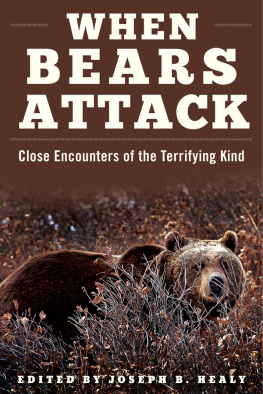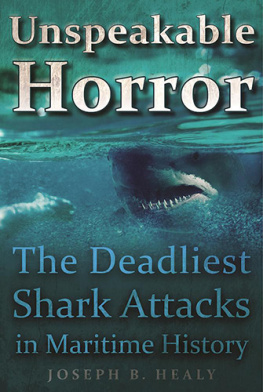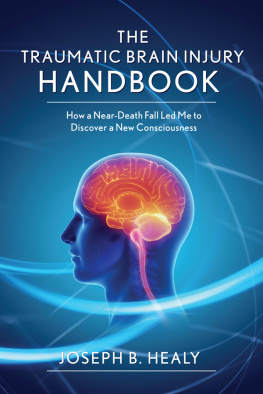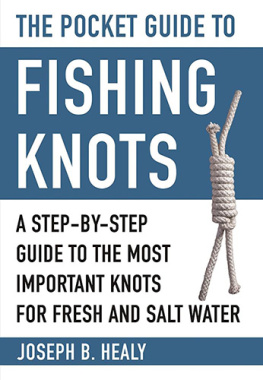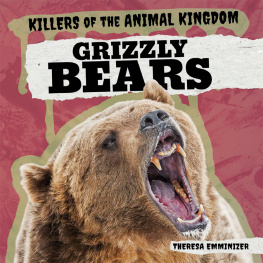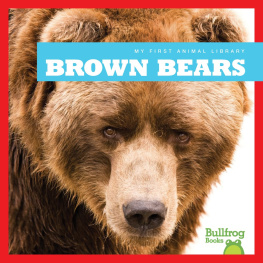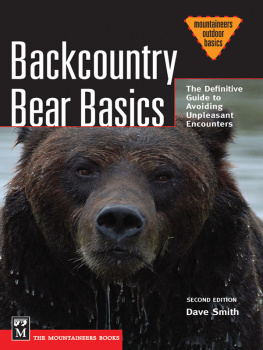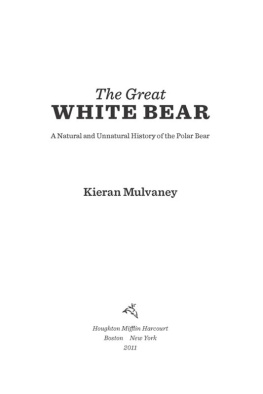Copyright 2016 by Joseph B. Healy
All rights reserved. No part of this book may be reproduced in any manner without the express written consent of the publisher, except in the case of brief excerpts in critical reviews or articles. All inquiries should be addressed to Skyhorse Publishing, 307 West 36th Street, 11th Floor, New York, NY 10018.
Individual stories reprinted here with permission.
Bear Awareness Gary Lewis; Bearing Up in Alaska by Jim Repine first published in Fly Fisherman Magazine, May 2007 issue, Vol. 38 Issue 4, Bob Noonan; Bear Attacks Happen Becky Blanton; Close Encouters in the Golden State James Swan, PhD; Ive Only Got to Outrun You first appeared in Sporting Classics magazine Todd Tanner; Three Bears! first appeared in Sporting Classics magazine Al Gilliam; Danger be Gone: Trapping a Grizzly Bear Kris Millgate; It Blew for Three Days Reid Bryant; Fearing Bears Joseph B. Healy
Skyhorse Publishing books may be purchased in bulk at special discounts for sales promotion, corporate gifts, fund-raising, or educational purposes. Special editions can also be created to specifications. For details, contact the Special Sales Department, Skyhorse Publishing, 307 West 36th Street, 11th Floor, New York, NY 10018 or .
Skyhorse and Skyhorse Publishing are registered trademarks of Skyhorse Publishing, Inc., a Delaware corporation.
Visit our website at www.skyhorsepublishing.com.
10 9 8 7 6 5 4 3 2 1
Library of Congress Cataloging-in-Publication Data is available on file.
Cover design by Tom Lau
Cover photo credit: Tim Irwin
Print ISBN: 978-1-5107-0717-7
Ebook ISBN: 978-1-5107-0719-1
Printed in the United States of America
DEDICATION:
TO ALL THOSE WHO ENCOUNTERED BEARS IN THE WILD AND LIVED TO TELL THEIR STORIES
EPIGRAPH
I TS VERY INTERESTING TO see an animal out in the wild that can kill you graveyard dead. The only thing I had seen that answered that description was a grizzly bear in Alaska. And thats an odd feeling, because theres no fence, and you know that after he gets tired of chasing marmots hes going to move in some other direction, which could be yours.
Cormac McCarthy, American novelist
CONTENTS
INTRODUCTION
By Joseph B. Healy, Editor
H ORRIPILATION IS THE WORD for goose flesh, when the hair on your body reflexively stands up because you know something is wrong, maybe that a threat is closing in and your brain registers fear, panic. Proprioception is the word for the sixth sense we humans have, sixth meaning its something beyond our five defined methods of perceptiontasting, smelling, hearing, touching, and seeing. Its our sense of our own self, but it may extend or array out from the body like a personal radar field, you might say. The neurologist Oliver Sacks (author of Awakenings , the book that later became the 1990 movie starring Robin Williams) wrote about this sense, and documented case studies in which a person lacking proprioception lacked awareness of his or her own body and so dwelled in constant disembodiment. But when you have it, as most of us do, maybe it helps us detect an impending threat to the bodyand contributes to the feeling swelling inside you that something is amiss. It becomes activated when we sense something is stalking us, for example. Thats when we begin to feel were in danger, our senses tingle, something doesnt feel right. In our brain, our amygdala goes on alert, ready to fight or flee.
Imagine that its a beara black bear or a grizzly is getting close. You smell the rotten meat stench of the bear (the perfume of a furry carnivore) and you feel the threat and time and distance compact as the moment closes inperhaps the moment to impact. Your inner voice screams, Dont run, itll only provoke the bear! Stop, drop, and play dead, and maybe the bear will only nudge or slightly maul you, pick at you, and move on. Youll be bleeding but at least youll be in one piece. Or maybe notmaybe the bear will taste flesh and keep biting and clawing, wanting to kill the food it thinks you are? Once youre dead, maybe the bear will decide you taste pretty good and are worth caching. The ghastly and brutal instinct (to us) of storing your corpse begins. The bear takes your arm in its jaws, pulls it free of your torso, stores the rest of your body under some brush, and returns to feast on your flesh and gnaw on your radius and ulna.
Bears are one of natures apex predators, gentle and fuzzy to watch from a distance (big teddy bears, right?) or at a zoo or on television, but fierce and unpredictable when arousedand then its too late for humans to escape a dangerous, fearsome, or fatal encounter.
In his book Bear Attacks: Their Causes and Avoidance (2002), the author Stephen Herrero, a professor and doctor of animal behavior, points out that the two common types of bear attacks are defensive (a mother bear defending her cubs) and predatory (the bear wants something to eat). In the prelude to impact, your survival may depend on recognizing the reason the bear is attacking. With defensive attacks, its usually best to play dead and wait for the threat to subside and the bear to move on; with predatory attacks, you often survive by fighting back. Herrero further states that most black bear attacks are predatory (as in A Predatory Kill and probably Nuisance Black Bear in these pages). Remember thisit could save your life one day. Beyond being entertained, youll find instructional benefits in many of these stories, in fact. For example, Todd Tanners story Ive Only Got to Outrun You gives some insight into what to doand not to dowhen a grizzly charges. The title of Todds story is a good punch line coming at the end of many survival stories, including one of my own (see Fearing Bears).
This book transports us to the domain of bears, from Maine to the Rocky Mountain West to Alaska. The stories give us a sense of the places in which bears live, and therefore where attacks occur.
I had to include some classic writing by Jack London to fully capture the frontier spirit that pervades this bookI really had no choice in the matter. London struck a rich vein of humanity when he went to the Klondike, though he never struck it rich with gold. No matter, his writing still takes us there and is its own reward. Another book that informed my sense of bear habitat was Coming Into the Country (1991) by John McPhee. I was drawn to it years ago for the fly-fishing writing, but stayed with it for the adventure of being in Alaska. He wrote about burning trash in Alaska because even unopened cans of sardines have been found in the scat of grizzlies. After a brief mention of a bear story about a camper on a bear trail getting eaten, McPhee moves on to cover Alaska, its terrain (three hundred and seventy-five million acres, he tells us), and its people. Maybe Im so fascinated with Alaska because as a boy I studied Sewards Folly, as the Alaska Territory purchase was called in 1867, and have fond memories of visiting the William H. Seward House in Auburn, New York, on a school fieldtrip. Sewards Folly or Sewards Icebox has brought prosperity to our country since its purchase under Secretary of State Seward from the Russians for seven million dollars in 1867. Part of that wealth is in literature. I had my own bear encounter in Alaska, which I dont write about in this book. It didnt escalate to a threatening situation, thanks to quick thinking by our jet-boat operator, Tim Rajeff, but it could have. We motored up on the bear in a remote stretch of river we were fishing for salmon; the bear reared up in alarm, and Rajeff stopped the boat with a power slide. I shot a few photos and we eased away. I still think about what might have happened if the power-slide stop had capsized the boat and we were in the water with the fishing bear. It was autumn and the bear was fattening up on salmon before the winter. The bear might have relished some flyfishermen as an entre.

